Role of Biosynthesized Silver Nanoparticles with Trigonella foenum-graecum Seeds in Wastewater Treatment
Abstract
:1. Introduction
2. Materials and Methods
2.1. Green Synthesis of Ag Nanoparticles
2.2. Characterization of Synthesized AgNPs
2.3. Treatment of Sewage Effluent by Synthesized AgNPs
2.4. Antibacterial Activity of Silver Nanoparticles
2.5. Statistical Analysis
3. Results and Discussion
3.1. Synthesis and Characterization of the Nanoparticles
3.1.1. UV–Vis Spectrophotometry
3.1.2. Size and Morphology of Nanoparticles
3.1.3. FTIR Analysis
3.1.4. Fluorescence Spectroscopy
3.1.5. X-ray Diffraction Analysis
3.2. Photocatalytic Degradation of Crystal Violet (CV) Dye by AgNPs
3.3. Water Quality Parameters of the Sewage Effluent
3.4. Antibacterial Activity of Trigonella/Ag-NPs
4. Conclusions
Author Contributions
Funding
Institutional Review Board Statement
Informed Consent Statement
Data Availability Statement
Conflicts of Interest
References
- Luthy, R.G.; Sedlak, D.L.; Plumlee, M.H.; Austin, D.; Resh, V.H. Wastewater-effluent-dominated streams as ecosystem-management tools in a drier climate. Front. Ecol. Environ. 2015, 13, 477–485. [Google Scholar] [CrossRef] [Green Version]
- Kalkan, C.; Yapsakl, K.; Mertoglu, B.; Tufan, D.; Saatci, A. Evaluation of Biological ActivatedCarbon (BAC) process in wastewater treatment secondary effluent for reclamation purposes. Desalination 2011, 265, 8. [Google Scholar] [CrossRef]
- Shittu, K.O.; Ihebunna, O. Purification of simulated waste water using green synthesized silver nanoparticles of Piliostigma thonningii aqueous leave extract. Adv. Nat. Sci. Nanosci. Nanotechnol. 2017, 8, 045003. [Google Scholar] [CrossRef] [Green Version]
- Jain, K.; Patel, A.S.; Pardhi, V.P.; Flora, S.J.S. Nanotechnology in Wastewater Management: A New Paradigm TowardsWastewater Treatment. Molecules 2021, 26, 1797. [Google Scholar] [CrossRef]
- Kumar, S.; Ahlawat, W.; Bhanjana, G.; Heydarifard, S.; Nazhad, M.M.; Dilbaghi, N. Nanotechnology-Based Water Treatment Strategies. J. Nanosci. Nanotechnol. 2014, 14, 1838–1858. [Google Scholar] [CrossRef]
- Ahmed, S.F.; Mofijur, M.; Ahmed, B.; Mehnaz, T.; Mehejabin, F.; Maliat, D.; Hoang, A.T.; Shafiullah, G.M. Nanomaterials as a sustainable choice for treating wastewater. Environ. Res. 2022, 214, 113807. [Google Scholar] [CrossRef]
- Lu, H.; Wang, J.; Stoller, M.; Wang, T.; Bao, Y.; Hao, H. An Overview of Nanomaterials for Water and Wastewater Treatment. Adv. Mater. Sci. Eng. 2016, 2016, 4964828. [Google Scholar] [CrossRef] [Green Version]
- Anjum, M.; Miandad, R.; Waqas, M.; Gehany, F.; Barakat, M.A. Remediation of wastewater using various nano-materials. Arab. J. Chem. 2019, 12, 4897–4919. [Google Scholar] [CrossRef] [Green Version]
- Malik, S.B.; Saggu, J.I.; Gul, A.; Abbasi, B.A.; Iqbal, J.; Waris, S.; Jardan, Y.A.B.; Chalgham, W. Synthesis and Characterization of Silver and Graphene Nanocomposites and Their Antimicrobial and Photocatalytic Potentials. Molecules 2022, 27, 5184. [Google Scholar] [CrossRef]
- Bruna, T.; Maldonado-Bravo, F.; Jara, P.; Caro, N. Silver Nanoparticles and Their Antibacterial Applications. Int. J. Mol. Sci. 2021, 22, 7202. [Google Scholar] [CrossRef]
- Haris, M.; Fatima, N.; Iqbal, J.; Chalgham, W.; Mumtaz, A.S.; El-Sheikh, M.A.; Tavafoghi, M. Oscillatoria limnetica Mediated Green Synthesis of Iron Oxide (Fe2O3) Nanoparticles and Their Diverse In Vitro Bioactivities. Molecules 2023, 28, 2091. [Google Scholar] [CrossRef]
- Ganguly, K.; Dutta, S.D.; Patel, D.K.; Lim, K. Chapter 18—Silver nanoparticles for wastewater treatment. In Micro and Nano Technologies, Aquananotechnology; Abd-Elsalam, K.A., Muhammad Zahid, M., Eds.; Elsevier: Amsterdam, The Netherlands, 2021; pp. 385–401. ISBN 9780128211410. [Google Scholar] [CrossRef]
- Galatage, S.T.; Hebalkar, A.S.; Dhobale, S.V.; Mali, O.R.; Kumbhar, P.S.; Nikade, S.V.; Killedar, S.G. Silver Nanoparticles: Properties, Synthesis, Characterization, Applications and Future Trends. In Silver Micro-Nanoparticles—Properties, Synthesis, Characterization, and Applications; IntechOpen: Rijeka, Croatia, 2021. [Google Scholar] [CrossRef]
- Mohammed, A.B.A.; Mohamed, A.; El-Naggar, N.E.; Mahrous, H.; Nasr, G.M.; Abdella, A.; Ahmed, R.H.; Irmak, S.; Elsayed, M.S.A.; Selim, S.; et al. Antioxidant and Antibacterial Activities of Silver Nanoparticles Biosynthesized by Moringa oleifera through Response Surface Methodology. J. Nanomater. 2022, 2022, 9984308. [Google Scholar] [CrossRef]
- Krishnaraj, C.; Jagan, E.G.; Rajasekar, S.; Selvakumar, P.; Kalaichelvan, P.T.; Mohan, N.J.C.S.B.B. Synthesis of silver nanoparticles using Acalypha indica leaf extracts and its antibacterial activity against water borne pathogens. Colloids Surf. B 2010, 76, 50–56. [Google Scholar]
- Ullah, Z.; Gul, F.; Iqbal, J.; Abbasi, B.A.; Kanwal, S.; Chalgham, W.; El-Sheikh, M.A.; Diltemiz, S.E.; Mahmood, T. Biogenic Synthesis of Multifunctional Silver Oxide Nanoparticles (Ag2ONPs) Using Parieteria alsinaefolia Delile Aqueous Extract and Assessment of Their Diverse Biological Applications. Microorganisms 2023, 11, 1069. [Google Scholar] [CrossRef]
- Vanlalveni, C.; Lallianrawna, S.; Biswas, A.; Selvaraj, M.; Changmai, B.; Rokhum, S.L. Green synthesis of silver nanoparticles using plant extracts and their antimicrobial activities: A review of recent literature. RSC Adv. 2021, 11, 2804–2837. [Google Scholar]
- Abbasi, B.A.; Iqbal, J.; Yaseen, T.; Zahra, S.A.; Ali, S.; Uddin, S.; Mahmood, T.; Kanwal, S.; El-Serehy, H.A.; Chalgham, W. Exploring Physical Characterization and Different Bio-Applications of Elaeagnus angustifolia Orchestrated Nickel Oxide Nanoparticles. Molecules 2023, 28, 654. [Google Scholar] [CrossRef]
- Vijayaraghavan, K.; Kamala Nalini, S.P.; Kannaian, U.P.N.; Dhakshinamoorthy, M. One step green synthesis of silver nano/microparticles using extracts of Trachyspermum ammi and Papaver somniferum. Colloids Surf. B 2012, 94, 114–117. [Google Scholar]
- Kumar, V.; Yadav, S.K. Synthesis of different-sized silver nanoparticles by simply varying reaction conditions with leaf extracts of Bauhinia variegata L. IET Nanobiotechnology 2010, 6, 1–8. [Google Scholar] [CrossRef]
- Guidelli, E.J.; Ramos, A.P.; Zaniquelli, M.E.D.; Baffa, O. Green synthesis of colloidal silver nanoparticles using natural rubber latex extracted from Hevea brasiliensis. Spectrochim. Acta Par A Mol. Biomol. Spectrosc. 2011, 82, 140–145. [Google Scholar]
- Tippayawat, P.; Phromviyo, N.; Boueroy, P.; Chompoosor, A. Green synthesis of silver nanoparticles in Aloe vera plant extract prepared by a hydrothermal method and their synergistic antibacterial activity. PeerJ 2016, 4, e2589. [Google Scholar]
- Vanti, G.L.; Nargund, V.B.; Basavesha, K.N.; Vanarchi, R.; Kurjogi, M.; Mulla, S.I.; Tubaki, S.; Patil, R.R. Synthesis of Gossypium hirsutum-derived silver nanoparticles and their antibacterial efficacy against plant pathogens. Appl. Organomet. Chem. 2019, 33, e4630. [Google Scholar] [CrossRef] [Green Version]
- Saratale, G.D.; Saratale, R.J.; Cho, S.; Ghodake, G.; Bharagava, R.N.; Park, Y.; Mulla, S.I.; Kim, D.; Kadam, A.; Nair, S.; et al. Investigation of photocatalytic degradation of reactive textile dyes by Portulaca oleracea-functionalized silver nanocomposites and exploration of their antibacterial and antidiabetic potential. J. Alloys Compd. 2020, 833, 155083. [Google Scholar] [CrossRef]
- Nagulapalli Venkata, K.C.; Swaroop, A.; Bagchi, D.; Bishayee, A. A small plant with big benefits: Fenugreek (Trigonella foenum-graecum Linn.) for disease prevention and health promotion. Mol. Nutr. Food Res. 2017, 61, 1600950. [Google Scholar] [CrossRef]
- Basu, T.K.; Srichamroen, A. Chapter—Health Benefits of Fenugreek (Trigonella foenum-graecum leguminosse). In Preedy, Bioactive Foods in Promoting Health; Watson, R.R., Victor, R., Eds.; Academic Press: Cambridge, MA, USA, 2010; pp. 425–435. ISBN 9780123746283. [Google Scholar] [CrossRef]
- Awad, M.A.; Hendi, A.A.; Ortashi, K.M.; Alzahrani, B.; Soliman, D.; Alanazi, A.; Alenazi, W.; Taha, R.M.; Ramadan, R.; El-Tohamy, M.; et al. Biogenic synthesis of silver nanoparticles using Trigonella foenum-graecum seed extract: Characterization, photocatalytic and antibacterial activities. Sens. Actuators A Phys. 2021, 323, 112670. [Google Scholar] [CrossRef]
- Rizwana, H.; Alwhibi, M.S.; Aldarsone, H.A.; Awad, M.A.; Soliman, D.A.; Bhat, R.S. Green synthesis, characterization, and antimicrobial activity of silver nanoparticles prepared using Trigonella foenum-graecum L. leaves grown in Saudi Arabia. Green Process. Synth. 2021, 10, 421–429. [Google Scholar] [CrossRef]
- Moond, M.; Singh, S.; Sangwan, S.; Devi, P.; Beniwal, A.; Rani, J.; Kumari, A.; Rani, S. Biosynthesis of Silver Nanoparticles Utilizing Leaf Extract of Trigonella foenum-graecum L. for Catalytic Dyes Degradation and Colorimetric Sensing of Fe3+/Hg2+. Molecules 2023, 28, 951. [Google Scholar] [CrossRef]
- Varghese, R.; Almalki, M.A.; Ilavenil, S.; Rebecca, J.; Choi, K.C. Silver nanopaticles synthesized using the seed extract of Trigonella foenum-graecum L. and their antimicrobial mechanism and anticancer properties. Saudi J. Biol. Sci. 2019, 26, 148–154. [Google Scholar] [CrossRef]
- Bhat, R.S.; Alghamdi, J.M.; Aldbass, A.M.; Aljebrin, N.A.; Alangery, A.B.; Soliman, D.A.; Al-Daihan, S. Biochemical and FT-IR profiling of Tritium aestivum L. seedling in response to sodium fluoride treatment. Fluoride 2022, 55, 81–89. [Google Scholar]
- Goyal, S.; Gupta, N.; Kumar, A.; Chatterjee, S.; Nimesh, S. Antibacterial, anticancer and antioxidant potential of silver nanoparticles engineered using Trigonella foenum-graecum seed extract. IET Nanobiotechnol. 2018, 12, 526–533. [Google Scholar] [CrossRef] [PubMed]
- Balouiri, M.; Sadiki, M.; Ibnsouda, S.K. Methods for in vitro evaluating antimicrobial activity: A review. J. Pharm. Anal. 2016, 6, 71–79. [Google Scholar] [CrossRef] [Green Version]
- Bratovcic, A. Biosynthesis of Green Silver Nanoparticles and Its UV-Vis Characterization. Int. J. Innov. Sci. Eng. Technol. 2020, 7, 170–176. [Google Scholar]
- Xia, Y.; Halas, N.J. Shape-controlled synthesis and surface plasmonic properties of metallic nanostructures. MRS Bull. 2005, 30, 338–348. [Google Scholar] [CrossRef] [Green Version]
- Duan, X.; Liu, N. Magnesium for dynamic nanoplasmonics. Acc. Chem. Res. 2019, 52, 1979–1989. [Google Scholar] [CrossRef] [PubMed] [Green Version]
- Bastús, N.G.; Piella, J.; Puntes, V. Quantifying the sensitivity of multipolar (dipolar, quadrupolar, and octapolar) surface plasmon resonances in silver nanoparticles: The effect of size, composition, and surface coating. Langmuir 2015, 32, 290–300. [Google Scholar] [PubMed]
- El-Desouky, N.; Shoueir, K.; El-Mehasseb, I.; El-Kemary, M. Synthesis of silver nanoparticles using bio valorization coffee waste extract: Photocatalytic flow-rate performance, antibacterial activity, and electrochemical investigation. Biomass Conv. Bioref. 2022, 1–15. [Google Scholar] [CrossRef]
- Ahani, M.; Khatibzadeh, M. Green synthesis of silver nanoparticles using gallic acid as reducing and capping agent: Effect of pH and gallic acid concentration on average particle size and stability. Inorg. Nano-Met. Chem. 2022, 52, 234–240. [Google Scholar]
- Ravichandran, V.; Vasanthi, S.; Shalini, S.; Shah, S.A.A.; Tripathyd, M.; Paliwala, N. Green synthesis, characterization, antibacterial, antioxidant and photocatalytic activity of Parkia speciosa leaves extract mediated silver nanoparticles. Results Phys. 2019, 15, 102565. [Google Scholar] [CrossRef]
- Meena, R.K.; Chouhan, N. Biosynthesis of silver nanoparticles from plant (fenugreek seeds) reducing method and their optical properties. Res. J. Recent. Sci. 2015, 2277, 2502. [Google Scholar]
- Bilal, M.; Khan, S.; Ali, J.; Ismail, M.; Khan, M.I.; Asiri, A.M.; Khan, S.B. Biosynthesized silver supported catalysts for disinfection of Escherichia coli and organic pollutant from drinking water. J. Mol. Liq. 2019, 281, 295–306. [Google Scholar] [CrossRef]
- Vijayakumar, M.; Priya, K.; Ilavenil, S.; Janani, B.; Vedarethinam, V.; Ramesh, T.; Arasu, M.V.; Al-Dhabi, N.A.; Kim, Y.O.; Kim, H.J. Shrimp shells extracted chitin in silver nanoparticle synthesis: Expanding its prophecy towards anticancer activity in human hepatocellular carcinoma HepG2 cells. Int. J. Biol. Macromol. 2020, 165, 1402–1409. [Google Scholar]
- Ikram, S.A.S. Silver Nanoparticles: One Pot Green Synthesis Using Terminalia arjuna Extract for Biological Application. J. Nanomed. Nanotechnol. 2015, 6, 1000309. [Google Scholar] [CrossRef] [Green Version]
- El-Kemary, M.; Zahran, M.; Khalifa, S.A.; El-Seedi, H.R. Spectral characterisation of the silver nanoparticles biosynthesized using Ambrosia maritima plant. Micro Nano Lett. 2016, 11, 311–314. [Google Scholar] [CrossRef]
- Kumar, P.P.N.V.; Pammi, S.V.N.; Pratap Kollu, S.K.V.V.; Shameem, U. Green synthesis and characterization of silver nanoparticles using Boerhaavia diffusa plant extract and their antibacterial activity. Ind. Crops Prod. 2014, 52, 562–566. [Google Scholar]
- Hay, P.J.; Wadt, W.R. Ab initio effective core potentials for molecular calculations. Potentials for the transition metal atoms Sc to Hg. J. Chem. Phys. 1985, 82, 270. [Google Scholar]
- Cao, G.; Wang, Y. Characterization and Properties of Nanomaterials. Nanostructures and Nanomaterials: Synthesis, Properties, and Applications; Volume 2 of World Scientific series in nanoscience and nanotechnology; World Scientific: Singapore, 2011; pp. 508, 581. ISBN 9814322504/9789814322. [Google Scholar]
- Swetha, V.; Lavanya, S.; Sabeena, G.; Pushpalaksmi, E.; Jenson, S.J.; Annadurai, G. Synthesis and characterization of silver nanoparticles from Ashyranthus aspera extract for antimicrobial activity studies. J. Appl. Sci. Environ. Manag. 2020, 24, 1161–1167. [Google Scholar]
- Ma, Y.; Tao, L.; Bai, S.; Hu, A. Green Synthesis of Ag Nanoparticles for Plasmon-Assisted Photocatalytic Degradation of Methylene Blue. Catalysts 2021, 11, 1499. [Google Scholar]
- Lee, S.H.; Jo, J.S.; Park, J.H.; Lee, S.W.; Jang, J.W. A hot-electron-triggered catalytic oxidation reaction of plasmonic silver nanoparticles evidenced by surface potential mapping. J. Mater. Chem. A 2018, 6, 20939–20946. [Google Scholar] [CrossRef]
- Rani, P.; Kumar, V.; Singh, P.P.; Matharu, A.S.; Zhang, W.; Kim, K.H.; Rawat, M. Highly stable AgNPs prepared via a novel green approach for catalytic and photocatalytic removal of biological and non-biological pollutants. Environ. Int. 2020, 143, 105924. [Google Scholar]
- Singh, J.; Kumar, V.; Jolly, S.S.; Kim, K.H.; Rawat, M.; Kukkar, D.; Tsang, Y.F. Biogenic synthesis of silver nanoparticles and its photocatalytic applications for removal of organic pollutants in water. J. Ind. Eng. Chem. 2019, 80, 247–257. [Google Scholar] [CrossRef]
- Jose, V.; Raphel, L.; Aiswariya, K.S.; Mathew, P. Green synthesis of silver nanoparticles using Annona squamosa L. seed extract: Characterization, photocatalytic and biological activity assay. Bioprocess. Biosyst. Eng. 2021, 44, 1819–1829. [Google Scholar]
- Kathiravan, V. Green synthesis of silver nanoparticles using different volumes of Trichodesma indicum leaf extract and their antibacterial and photocatalytic activities. Res. Chem. Intermed. 2018, 44, 4999–5012. [Google Scholar] [CrossRef]
- Anjana, V.N.; Joseph, M.; Francis, S.; Joseph, A.; Koshy, E.P.; Mathew, B. Microwave assisted green synthesis of silver nanoparticles for optical, catalytic, biological and electrochemical applications. Artif. Cells Nanomed. Biotechnol. 2021, 49, 438–449. [Google Scholar] [CrossRef] [PubMed]
- Perez, M. The Effects of Silver Nanoparticles on Wastewater Treatment and Escherichia Coli Growth. Bachelor’s Thesis, Florida State University, Tallahassee, FL, USA, 2012. [Google Scholar]
- Najafpoor, A.; Norouzian-Ostad, R.; Alidadi, H.; Rohani-Bastami, T.; Davoudi, M.; Barjasteh-Askari, F.; Zanganeh, J. Effect of magnetic nanoparticles and silver-loaded magnetic nanoparticles on advanced wastewater treatment and disinfection. J. Mol. Liq. 2020, 303, 112640. [Google Scholar] [CrossRef]
- Epelle, E.I.; Okoye, P.U.; Roddy, S.; Gunes, B.; Okolie, J.A. Advances in the Applications of Nanomaterials for Wastewater Treatment. Environments 2022, 9, 141. [Google Scholar] [CrossRef]
- Li, H.; Gao, Y.; Li, C.; Ma, G.; Shang, Y.; Sun, Y. A comparative study of the antibacterial mechanisms of silver ion and silver nanoparticles by Fourier transform infrared spectroscopy. Vib. Spectrosc. 2016, 85, 112–121. [Google Scholar] [CrossRef]
- Sabry, N.; Tolba, S.; Kh, F.; Abdel-Gawad, F.; Bassem, S.; Hossam, F.; El-Taweel, G.E.; Okasha, A.; Ibrahim, M. Interaction between nano silver and bacteria: Modeling approach. Biointerface Res. Appl. Chem. 2018, 8, 3570–3574. [Google Scholar]
- Singha, K.; Pandit, P.; Maity, S.; Sharma, S.R. Harmful environmental effects for textile chemical dyeing practice. In Green Chemistry for Sustainable Textiles; Woodhead Publishing: Cambridge, UK, 2021; pp. 153–164. [Google Scholar]
- Dutta, S.; Bhattacharjee, J. A comparative study between physicochemical and biological methods for effective removal of textile dye from wastewater. In Development in Wastewater Treatment Research and Processes; Elsevier: Amsterdam, The Netherlands, 2022; pp. 1–2. [Google Scholar]
- Patil, R.; Zahid, M.; Govindwar, S.; Khandare, R.; Vyavahare, G.; Gurav, R.; Desai, N.; Pandit, S.; Jadhav, J. Constructed wetland: A promising technology for the treatment of hazardous textile dyes and effluent. In Development in Wastewater Treatment Research and Processes; Elsevier: Amsterdam, The Netherlands, 2022; pp. 173–198. [Google Scholar]
- Al-Tohamy, R.; Ali, S.S.; Li, F.; Okasha, K.M.; Mahmoud, Y.A.G.; Elsamahy, T.; Jiao, H.; Fu, Y.; Sun, J. A critical review on the treatment of dye-containing wastewater: Ecotoxicological and health concerns of textile dyes and possible remediation approaches for environmental safety. Ecotoxicol. Environ. Saf. 2022, 231, 13160. [Google Scholar] [CrossRef]
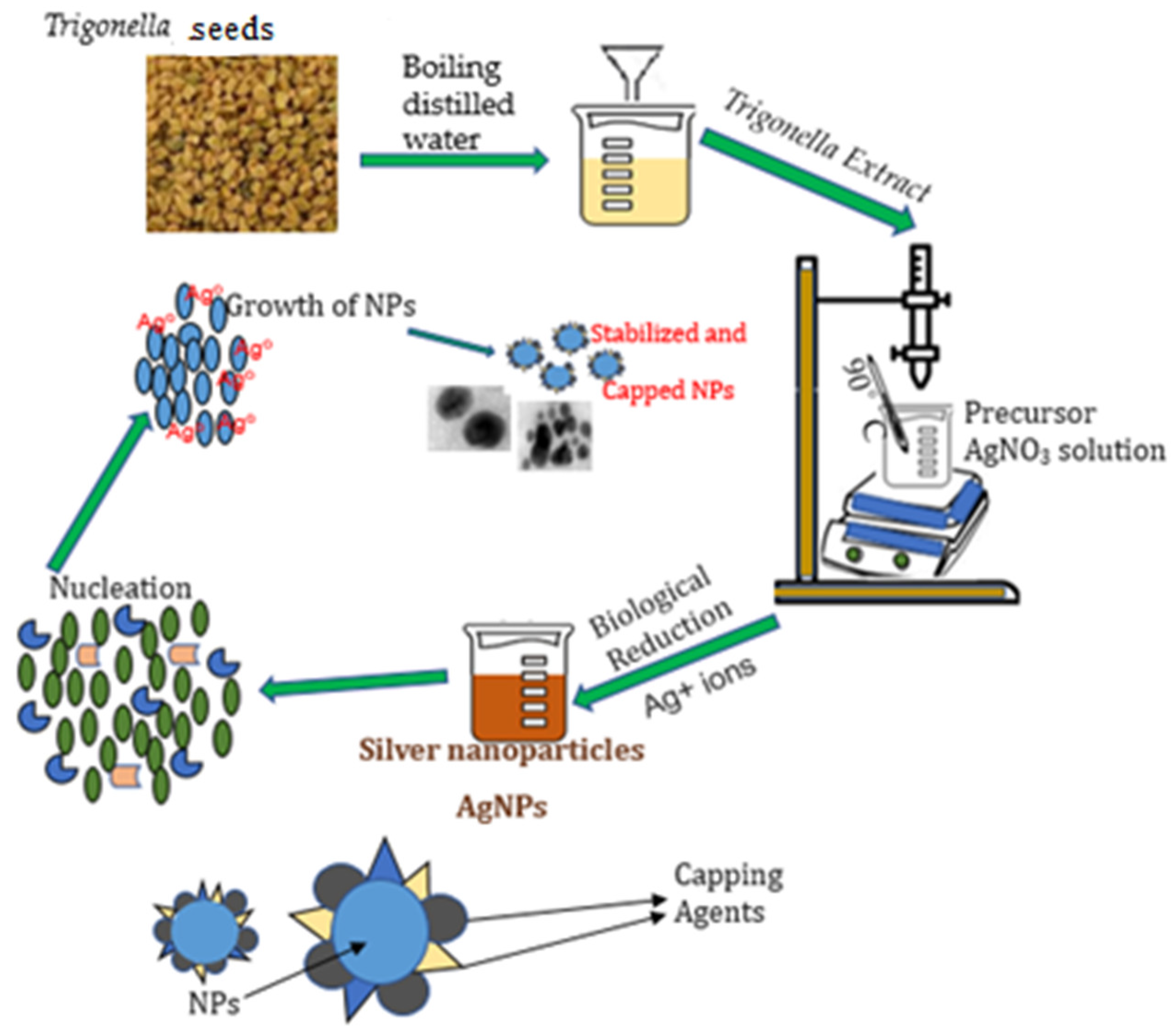

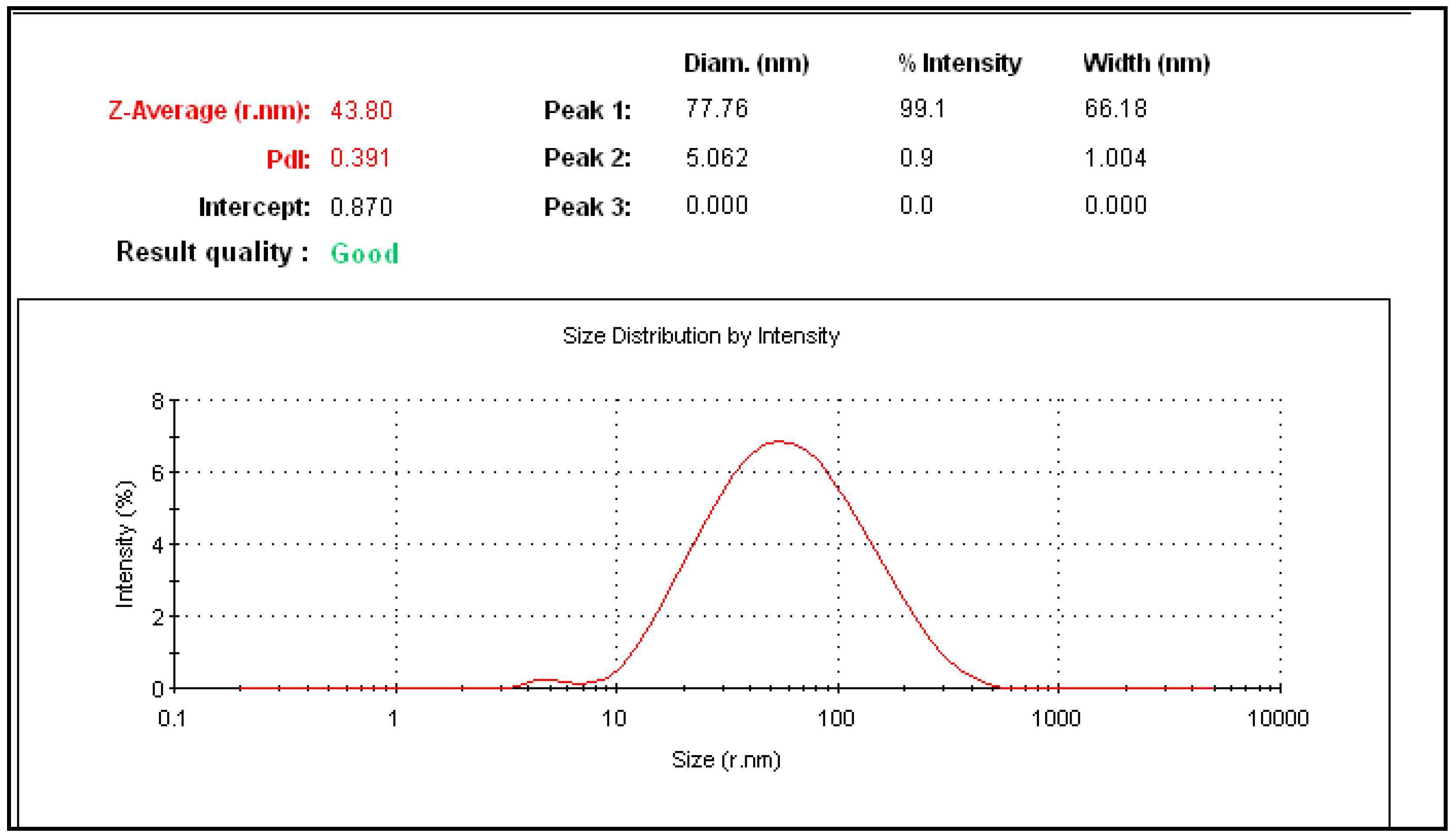
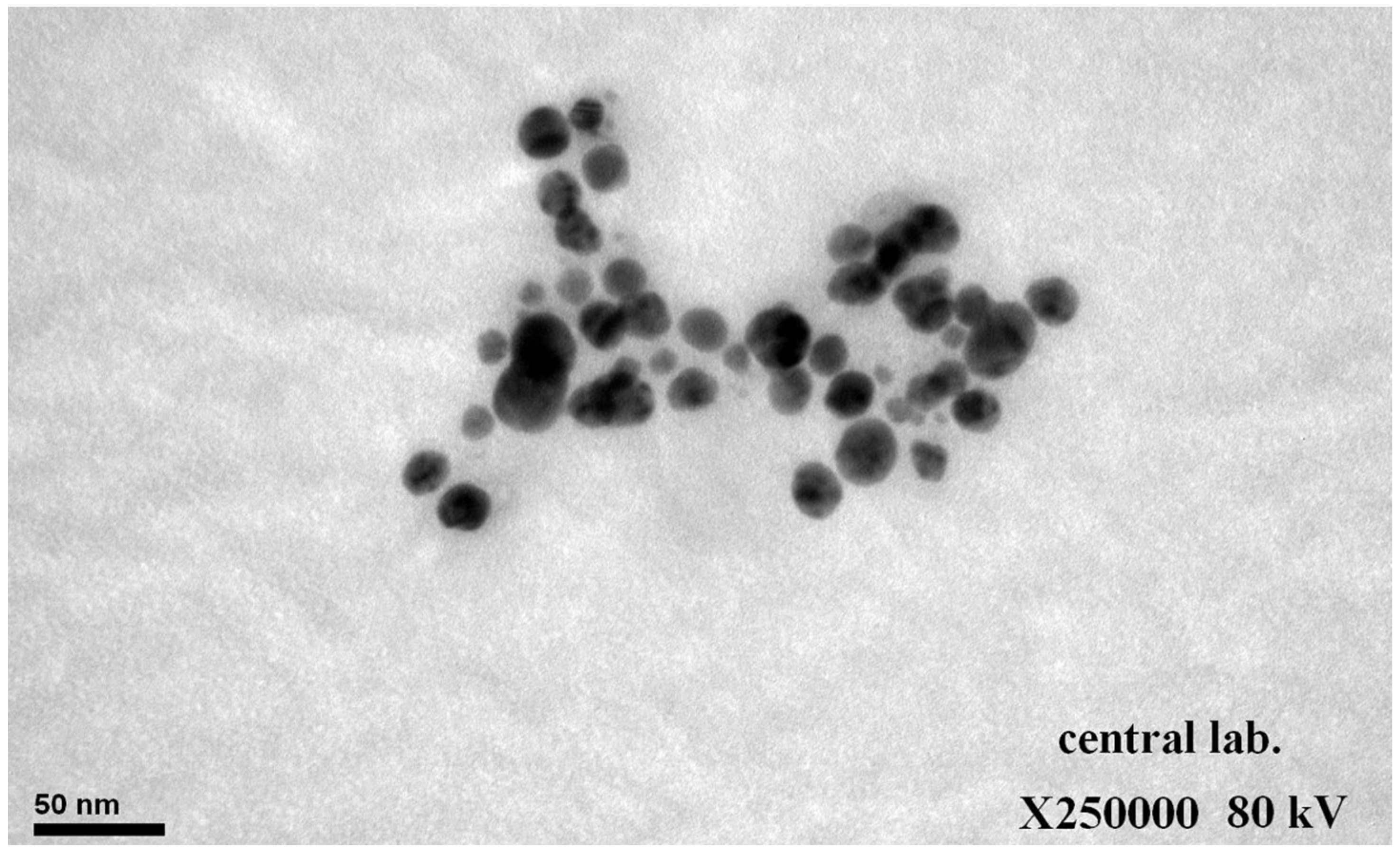
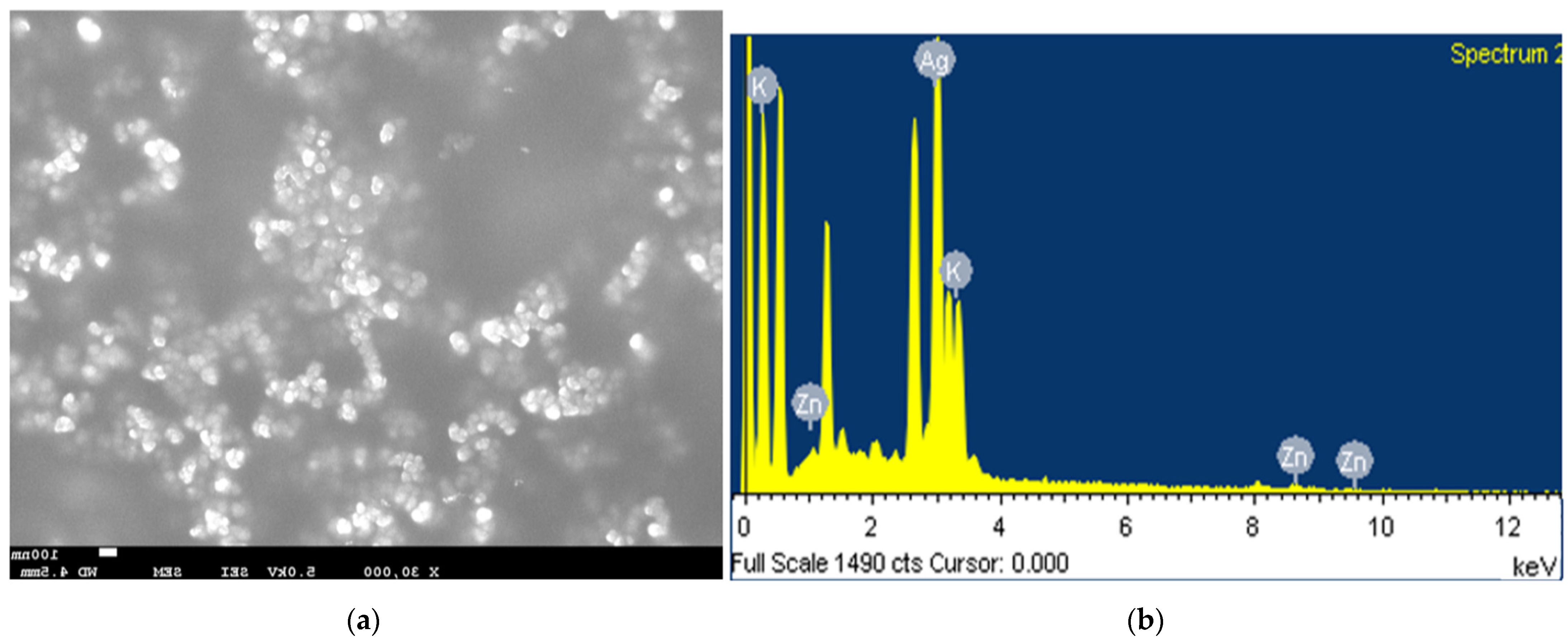
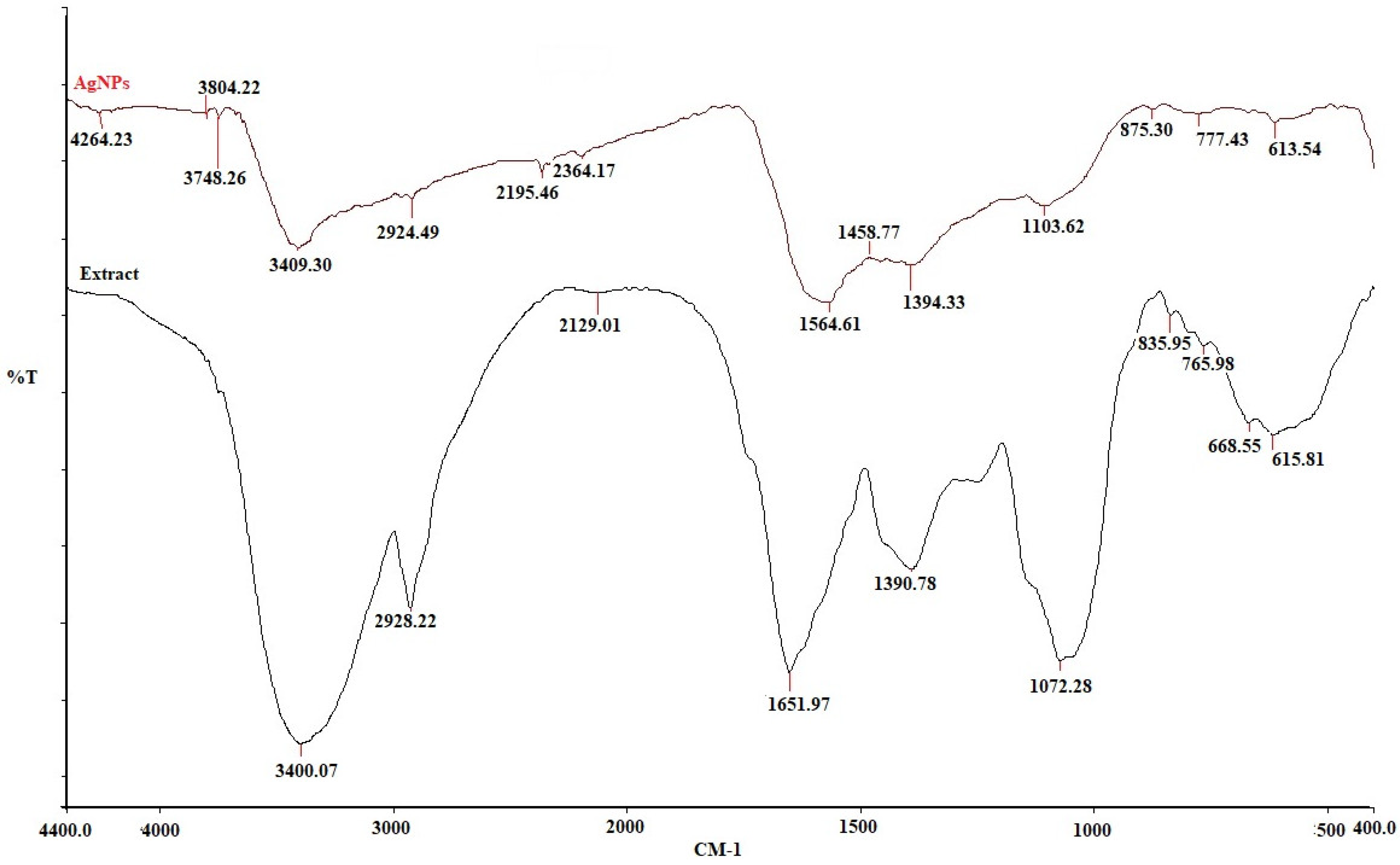
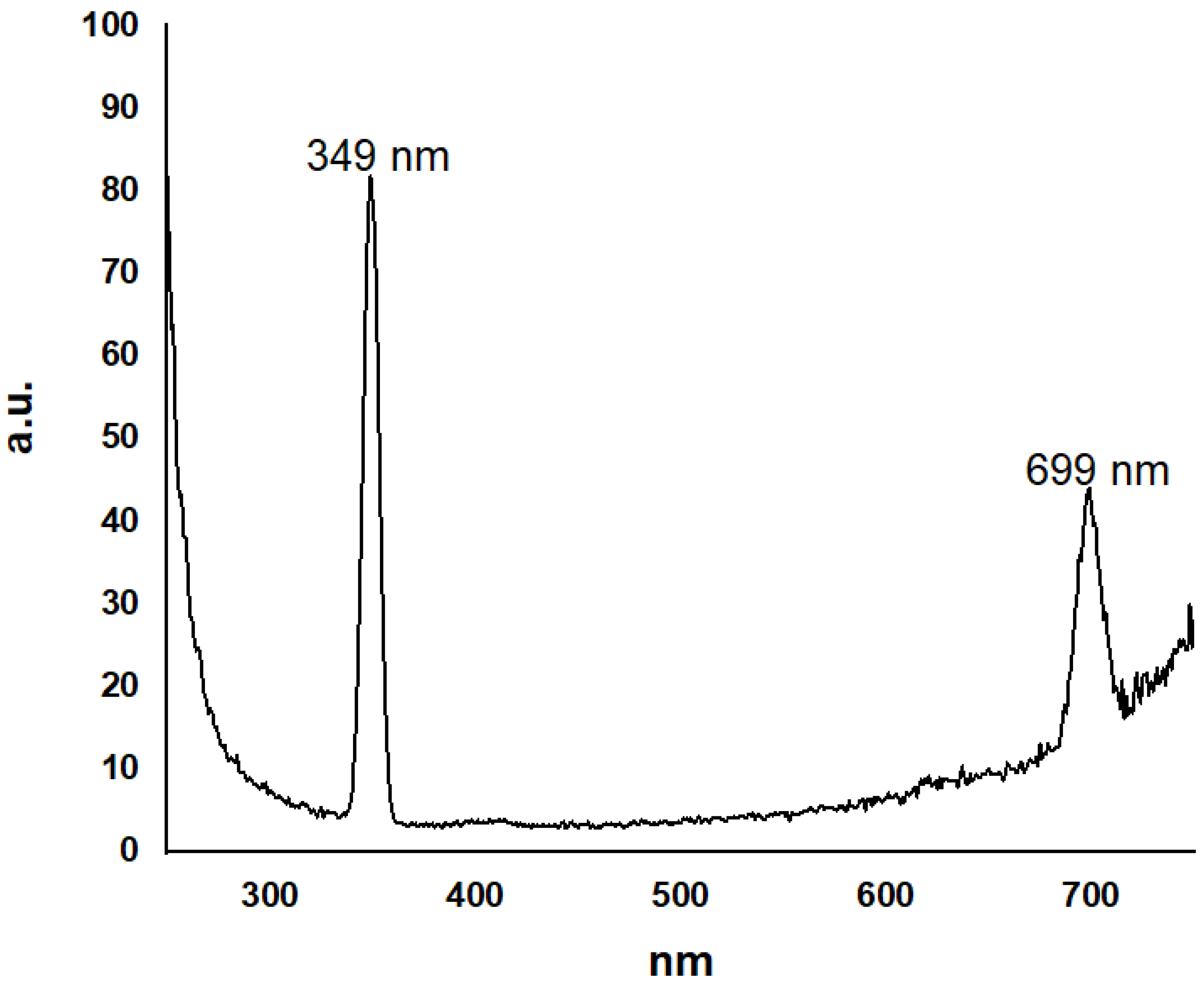
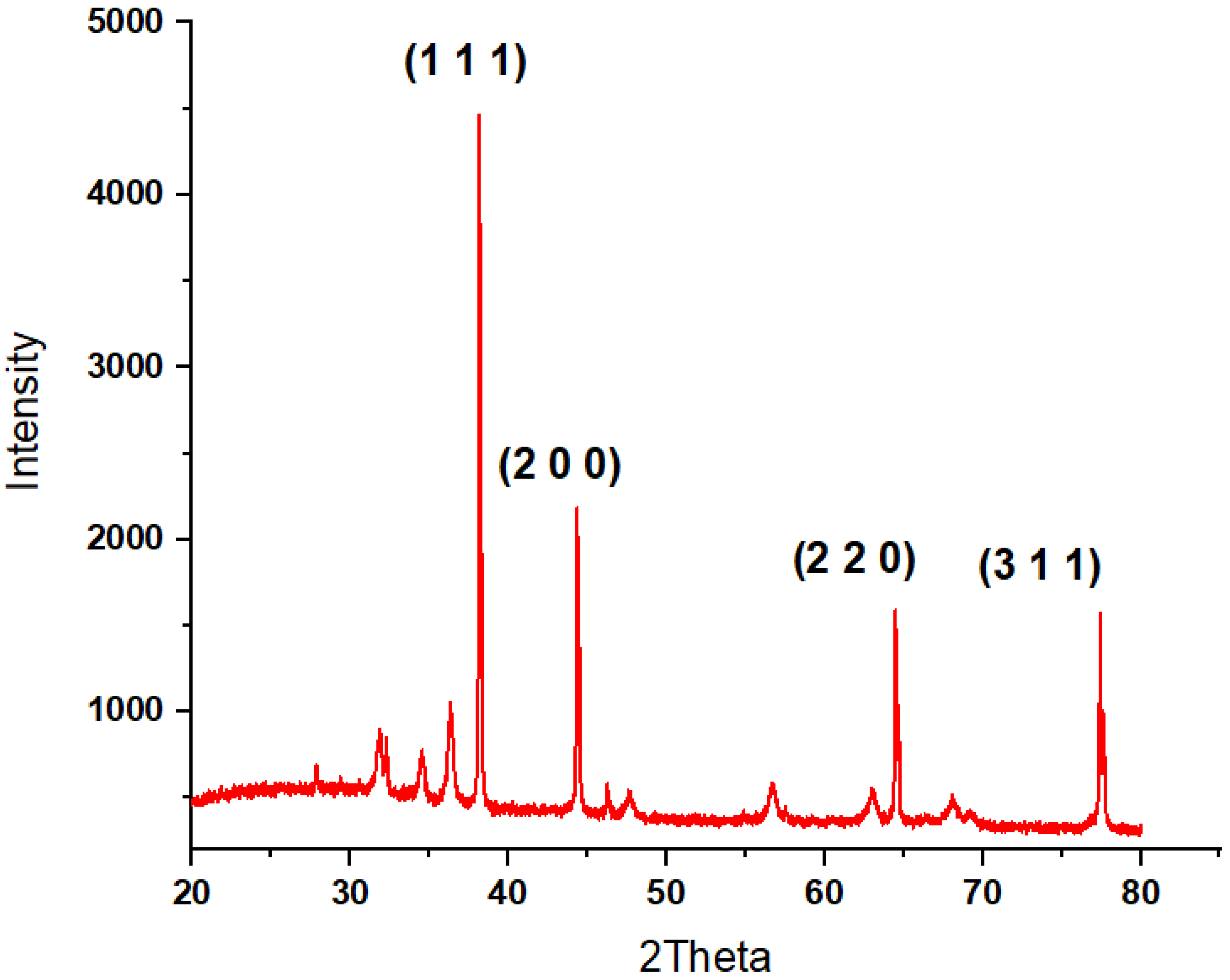
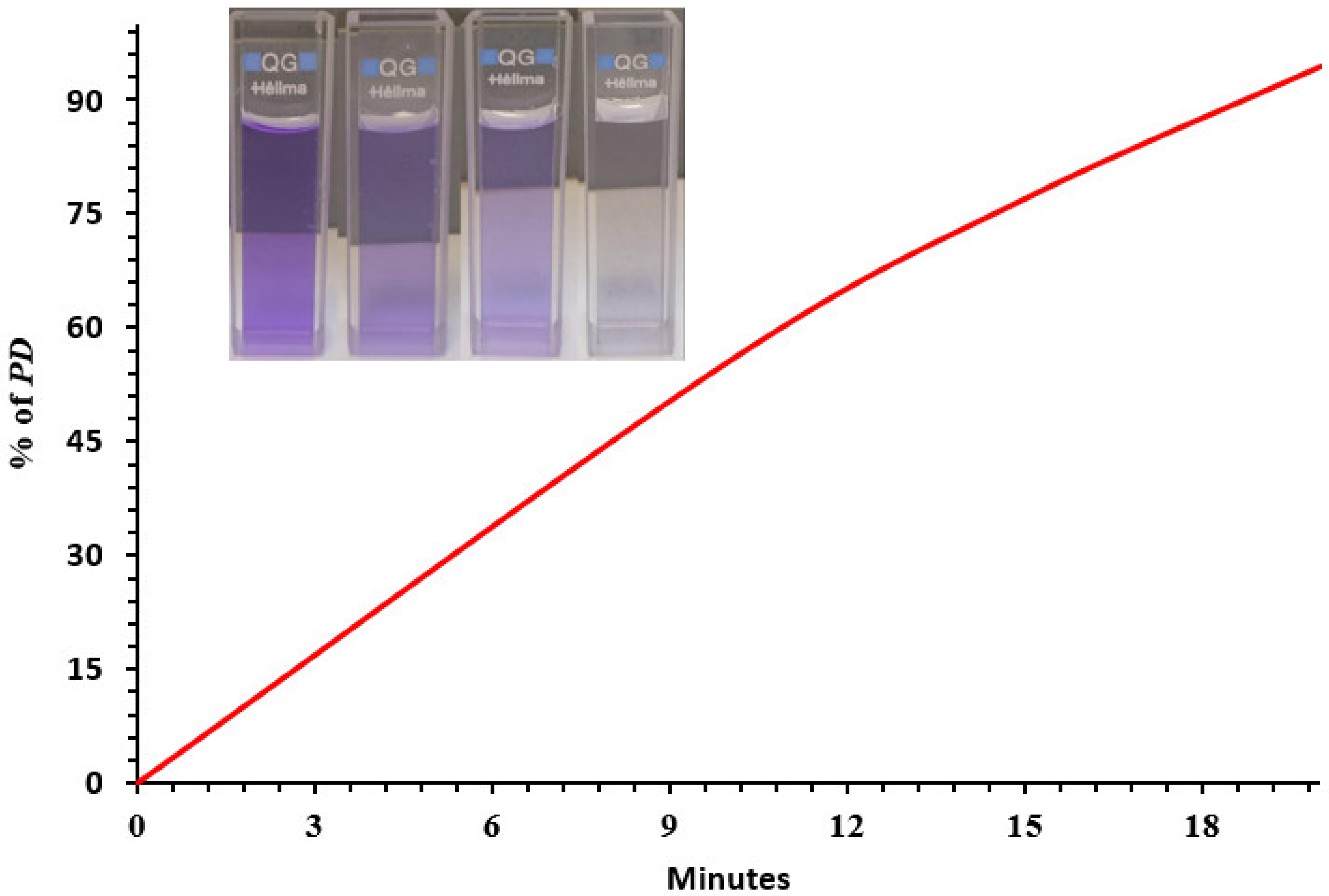
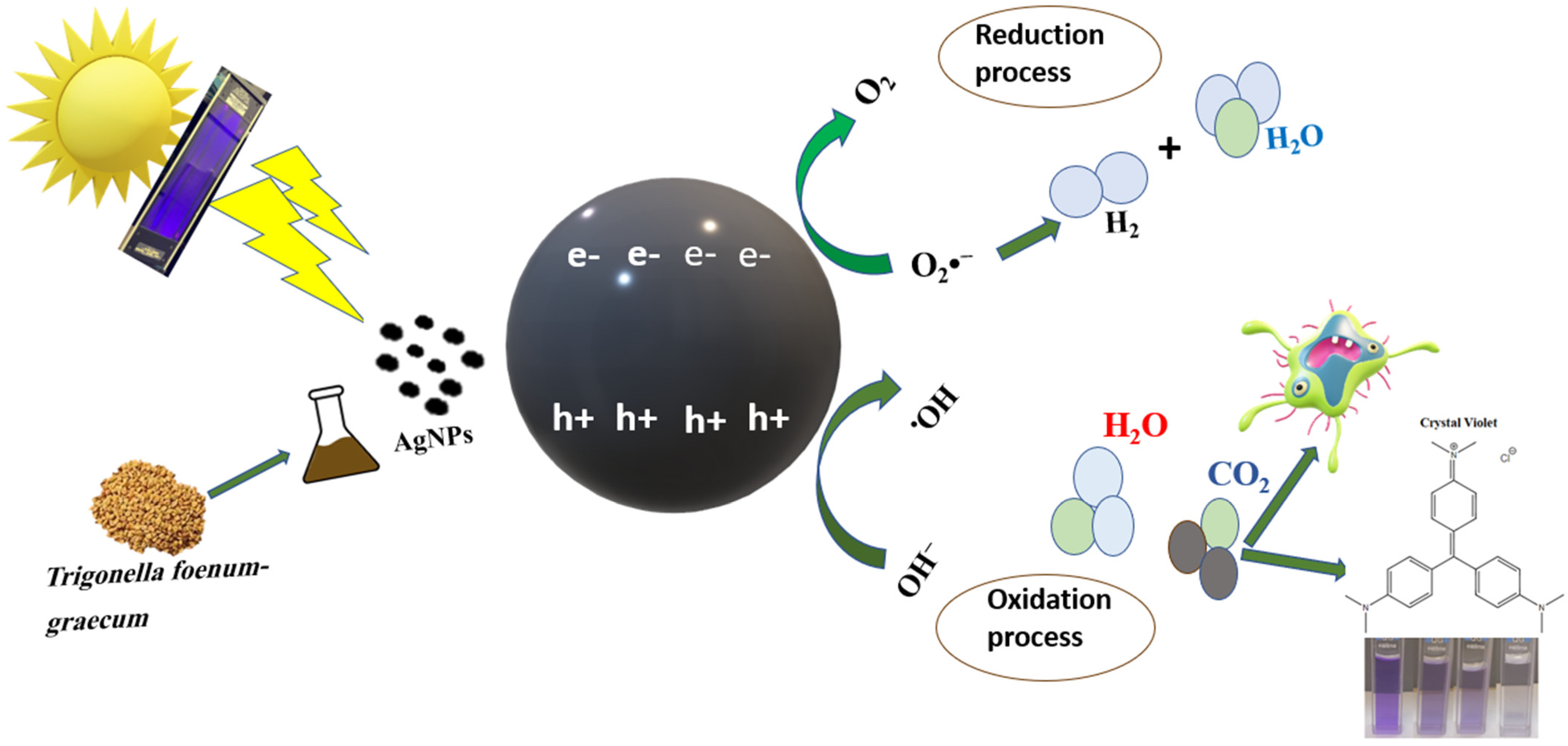
| Plant | Size (nm) | Illumination Source | Dye/Concentration | Degradation Time/Percentage | Reference |
|---|---|---|---|---|---|
| Phaseolus vulgaris (kidney beans) | 10–20 nm | Sunlight | RR-141 (50 mL, 20 ppm) |
150 min 97% | (Rani et al., 2020) [52] |
| Trigonella foenum-graecum leaf | 5–20 nm | Sunlight | Blue 19 (RB19) and reactive yellow 186 (RY186); respectively | 180 min/88% and 86%; respectively | (Singh et al., 2019) [53] |
| Annona squamosa L. | 22 nm | Sunlight | Coomassie brilliant blue(CBB)/5 mL of 1% CBB | Gradually degradation/(10, 20, 30 min) | (Jose et al., 2021) [54] |
| Trichodesma indicum leaf | 35–33 nm | Solar light | Methylene blue (MB) dye/200 mL aqueous solution of MB | 82% of MB within 210 min | (Kathiravan et al., 2018) [55] |
| Cyanthillium cinereum leaf | 5–40 nm | Without light irradiation | Methylene blue and fuchsine in the presence of aq.NaBH4/(0.08 × 10−3 M) of the dyes | Gradual degradation | (Anjana et al., 2021) [56] |
| Trigonella foenum-graecum seeds | 82.53 nm | UV light | Rhodamine B dye/10 μgL−1 | (93%) with decoloration after 216 h | (Awad et al., 2021) [27] |
| Trigonella foenum-graecum seeds | 43.80 nm | UV light | Crystal violet/10−6 M of dye | 94.5% with in 20 min | Present study |
| Parameter | Tap Water | Untreated Sewage Effluent | Sewage Effluent Treated with Trigonella Ag-NPs |
|---|---|---|---|
| pH | 7.96 ± 0.04160 a | 8.77 ± 01966 b | 7.15 ± 0.1101 c |
| EC (ppm) | 692.23 ± 4.6801 a | 1269.36 ± 2.6350 b | 726.06 ± 3.5232 c |
| SO4 (ppm) | 48.43 ± 0.5132 a | 166.900 ± 1.3892 b | 46.67 ± 0.7571 a |
| Cl (ppm) | 75.70 ± 0.6083 a | 552.93 ± 1.6773 b | 182.93 ± 2.2679 c |
| HCO3 (ppm) | 64.63 ± 0.6806 a | 57.53 ± 0.6658 b | 66.03 ± 0.3055 a |
| Mg+2 (ppm) | 29.73 ± 0.2309 a | 81.55 ± 0.4500 b | 47.53 ± 0.5033 c |
| Ca+2 (ppm) | 82.87 ± 1.0263 a | 136.03 ± 1.0016 b | 104.10 ± 0.3605 c |
| COD (mg/L) | 0.77 ± 0.0577 a | 1135.67 ± 8.6217 b | 805.20 ± 4.9518 c |
| BOD (mg/L) | 0.00 ± 0.0000 a | 49.17 ± 0.9609 b | 21.57 ± 0.5131 c |
| Bacterial Strain | AgNps | Bulk Trigonella Seed Extract | |
|---|---|---|---|
| 1 µg/mL | 0.5 µg/mL | ||
| Escherichia coli (Gram-negative) | 24 mm | 20 mm | 15 mm |
| Staphylococcus aureus (Gram-positive) | 30 mm | 27 mm | 14 mm |
Disclaimer/Publisher’s Note: The statements, opinions and data contained in all publications are solely those of the individual author(s) and contributor(s) and not of MDPI and/or the editor(s). MDPI and/or the editor(s) disclaim responsibility for any injury to people or property resulting from any ideas, methods, instructions or products referred to in the content. |
© 2023 by the authors. Licensee MDPI, Basel, Switzerland. This article is an open access article distributed under the terms and conditions of the Creative Commons Attribution (CC BY) license (https://creativecommons.org/licenses/by/4.0/).
Share and Cite
Awad, M.A.; Virk, P.; Hendi, A.A.; Ortashi, K.M.; AlMasoud, N.; Alomar, T.S. Role of Biosynthesized Silver Nanoparticles with Trigonella foenum-graecum Seeds in Wastewater Treatment. Processes 2023, 11, 2394. https://doi.org/10.3390/pr11082394
Awad MA, Virk P, Hendi AA, Ortashi KM, AlMasoud N, Alomar TS. Role of Biosynthesized Silver Nanoparticles with Trigonella foenum-graecum Seeds in Wastewater Treatment. Processes. 2023; 11(8):2394. https://doi.org/10.3390/pr11082394
Chicago/Turabian StyleAwad, Manal A., Promy Virk, Awatif A. Hendi, Khalid Mustafa Ortashi, Najla AlMasoud, and Taghrid S. Alomar. 2023. "Role of Biosynthesized Silver Nanoparticles with Trigonella foenum-graecum Seeds in Wastewater Treatment" Processes 11, no. 8: 2394. https://doi.org/10.3390/pr11082394






